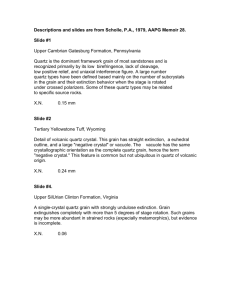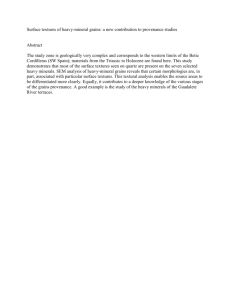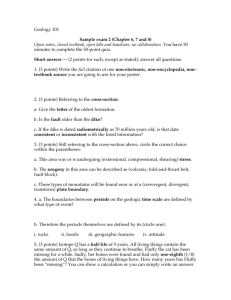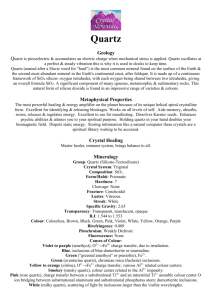GEOS 254 Sol St Mst
advertisement
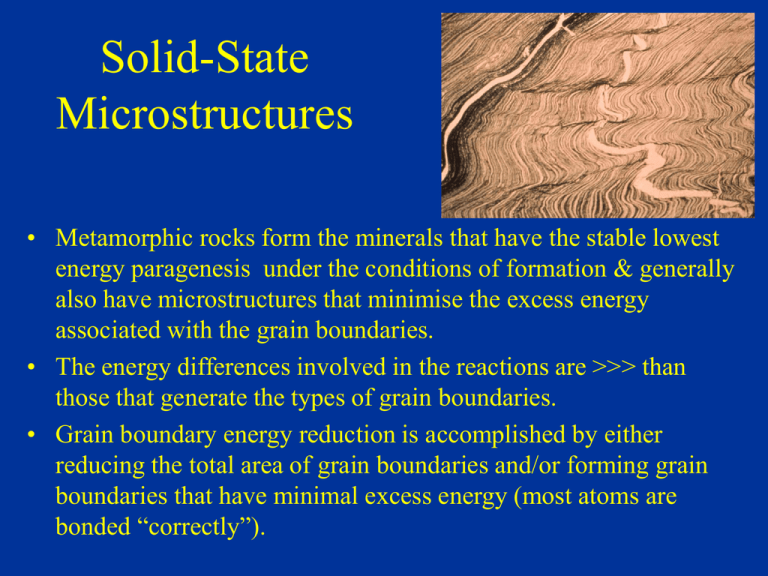
Solid-State Microstructures • Metamorphic rocks form the minerals that have the stable lowest energy paragenesis under the conditions of formation & generally also have microstructures that minimise the excess energy associated with the grain boundaries. • The energy differences involved in the reactions are >>> than those that generate the types of grain boundaries. • Grain boundary energy reduction is accomplished by either reducing the total area of grain boundaries and/or forming grain boundaries that have minimal excess energy (most atoms are bonded “correctly”). Reduction in grain-boundary energy • The excess energy because of imperfect bonding of atoms in the grain-boundaries is reduced by: • Reducing the total area of grain-boundaries by: – Forming polygonal grains that have low surface area (the solid space filling 3D equivalent of spheres) and – By increasing the grain size that also reduces the total area of grain-boundaries (1000 mm cubes have a surface of 60 cm2, one cm cube has the same volume and only 6 cm2 surface area). • Or by forming crystal faces that have most of the bonds in one crystal satisfied as is the case for mica (001) faces. Minerals can be roughly subdivided into those that have an isotropic structure and those that are strongly structurally anisotropic • Quartz, feldspar and calcite are “isotropic” • Micas, chlorite, sillimanite are very anisotropic. • Most single mineral metamorphic rocks are polygonal. • With two or more it depends on the individual minerals. Isotropic minerals form polygonal or “foam-like” aggregates • Small grains tend to have fewer face, larger ones more. • Small grains have more curved faces but all faces are curved and not related to crystallography (e.g. not cleavage parallel. • Small grains are removed by the enlargement of large grains (process can be seen in foams). This is easier if the rock in monomineralic (e.g. marble). Micas are very anisotropic & have very few bonds that cross the (001) plane • Aligned mica that has (001) faces that quartz just moulds onto. The mica (001) is so stable the quartz-quartz boundaries meet it at right angles. • Quartz and feldspar forms a polygonal array except where biotite (001) faces control the shapes. Polygonal vs Polyhedral • Apart from micas and sillimanite, most single mineral aggregates are polygonal. • Quartz and feldspar are similar enough to form a polygonal aggregate. • Olivine and pyroxene also form polygonal aggregates. • Silicates enclosed in calcite are polyhedral. • Even some fluid inclusions can be polyhedral (negative crystals) e.g. in fluorite Polyhedral Porphyroblasts INCLUSIONS • Inclusions have grain boundaries and the same rules apply. • “Isotropic” minerals generally form sub-spherical grains. • The micas inclusions form the sheets (001) but have hemispherical ends. • Hornblende forms some faces in quartz. Solid state growth twins • Pre-impingement twins grow behind the advancing interface, post impingement twins develop at triple junctions. Sector twins form as a result of polymorphic transformation (e.g. cordierite). • Plagioclase has sparse solid state growth twins (can have many deformation twins). • The amphibole cummingtonite has abundant growth multiple twins. Radiating Aggregates • Large grain boundary area with energy reduced by formation of crystal faces but still higher than equant aggregates. • Form as a result of very low nucleation and diffusion rates (like spherulites). • Formed by “anisotropic minerals like chlorite and sillimanite. • Imply absence of deformation during growth especially if three dimensional. Zoning in Metamorphic minerals • Shown by: zones of inclusions and/or chemical zoning. • Mineral maps using EMP reveal zoning is common but it is rare to have oscillatory zoning. • Almandine Garnet commonly has Mn-rich cores recording the garnet that forms in meta-mudstones at the lowest T surrounded by higher temperature more almandine pyrope-rich rims. • Symplectites: pseudomorphous replacement Intergrowths and may form coronas. Generally post-deformation and indicate simultaneous growth of all minerals. If some of the original minerals remains as a core they indicate the reaction. • Upper photo is symplectic intergrowth of biotite, quartz and andalusite that replaces cordierite. (A) Degree of discordance for two grains of the same mineral • Grains that are close to having the same orientation have low energy (most atoms get to bond correctly). • This explains how the radiating fibres in spherulites justify their existence. • High angles have high energy unless you fluke a twin orientation. • Myrmekite an intergrowth of plagioclase and quartz that commonly develops on existing plagioclase and replaces adjacent K-feldspar. The plagioclase is all in optical continuity as is the quartz that forms worm-like inclusions. • Occurs in granitic rocks especially if slightly deformed. Deformation allows in the H2O needed to bring the components Ca & Na in and K out. INTERGROWTHS cont. Incomplete Metamorphic Reactions • Common only in low temp. prograde and retrograde metamorphic rocks. At higher temp. reactions go to completion. Commonly reflect the slow entry of H2O into the rock. Photo of igneous pyroxene phenocryst partly replaced by hornblende. If not deformed igneous microstructures can be preserved. Preservation of Pre-metamorphic Structures • Favoured by minimal deformation. • Unreactive rock (e.g. quartz sandstone that can show crossbedding at granulite facies. • Several stages of growth of porphyroblasts that can preserve structure as inclusions.

